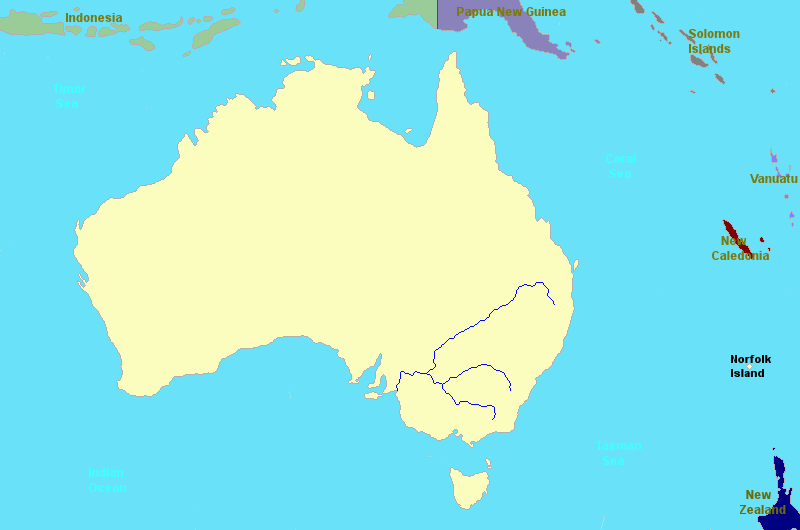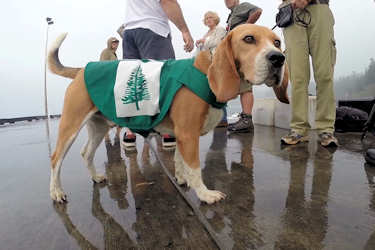Australia

Historie
Human habitation of the Australian continent is estimated to have begun between 42.000 and 48.000 years ago, possibly with
the migration of people by land bridges and short sea-crossings from what is now South-East Asia.
At the time of European settlement in the late 18th century, most Indigenous Australians were hunter-gatherers, with a complex
oral culture and spiritual values based on reverence for the land and a belief in the Dreamtime.
The first recorded European sighting of the Australian mainland, and the first recorded European landfall on the Australian continent,
are attributed to the Dutch navigator Willem Janszoon. He sighted the coast of Cape York Peninsula in early 1606, and
made landfall on 26 February at the Pennefather River near the modern town of Weipa on Cape York. The Dutch charted the whole of the
western and northern coastlines and named the island continent "New Holland" during the 17th century, but made no attempt at settlement.
On 24 November 1642 Abel Tasman sighted the west coast of Tasmania. He named his discovery Van Diemen's Land after
Antonio van Diemen, Governor-General of the Dutch East Indies.
In 1770, James Cook sailed along and mapped the east coast, which he named New South Wales and claimed for Great Britain.
With the loss of its American colonies in 1783, the British Government sent a fleet of ships, the "First Fleet", under the command
of Captain Arthur Phillip, to establish a new penal colony in New South Wales. A camp was set up and the flag raised at Sydney Cove,
on 26 January 1788, a date which became Australia's national day.
Most early convicts were transported for petty crimes and assigned as labourers or servants upon arrival. While the majority settled into
colonial society once emancipated, convict rebellions and uprisings were also staged, but invariably suppressed under martial law.
The 1808 Rum Rebellion, the only successful armed takeover of government in Australia, instigated a two-year period of military rule.
The expansion of British control over other areas of the continent began in the early 19th century, initially confined to coastal regions.
A British settlement was established in Van Diemen's Land, now known as Tasmania, in 1803 and it became a separate colony in 1825.
The British claim was extended to the whole Australian continent in 1827 when Major Edmund Lockyer established a settlement on
King George Sound. The Swan River Colony was established in 1829, evolving into the largest Australian colony by area,
Western Australia.
A gold rush began in Australia in the early 1850s and the Eureka Rebellion against mining licence fees in 1854 was an early
expression of civil disobedience. Between 1855 and 1890, the six colonies individually gained responsible government, managing most of
their own affairs while remaining part of the British Empire. The Colonial Office in London retained control of some matters, notably
foreign affairs, defence, and international shipping.
On 1 January 1901, federation of the colonies was achieved after a decade of planning, consultation and voting. This established the
Commonwealth of Australia as a dominion (semi-independent state) of the British Empire.
Australia became the colonial ruler of the Territory of Papua in 1902 and of the Territory of New Guinea in 1920. The two were
unified as the Territory of Papua and New Guinea in 1949 and gained independence from Australia in 1975.
The shock of Britain's defeat in Asia in 1942, followed soon after by the bombing of Darwin and other Japanese attacks, led to a widespread
belief in Australia that an invasion was imminent, and a shift towards the United States as a new ally and protector.
Since 1951, Australia has been a formal military ally of the US, under the Australia, New Zealand, United States Security Treaty
(ANZUS treaty).
The final constitutional ties between Australia and the UK were severed with the passing of the Australia Act 1986, ending any
British role in the government of the Australian States, and closing the option of judicial appeals to the Privy Council in London.
In the 1983 Australian Federal Election the incumbent Coalition government which had been in power since 1975, led by
Malcolm Fraser (Liberal Party) and Doug Anthony (National Party), was defeated in a landslide by the opposition Labor Party
led by Bob Hawke. Hawke retained office until a 1991 Labor Party spill saw him replaced by Paul Keating.
John Howard with a Liberal–National Party coalition served as Prime Minister from 1996 until 2007. Howard was defeated in 2007 and
the Labor Party's Kevin Rudd held the office until June 2010
I have visited Australia in april 2015.
It was a part of the West Pacific Odessey.
On that trip i have seen
Norfolk Island
Please let me know when you're having questions.
i would be pleased to help you.
Things to do and other tips
